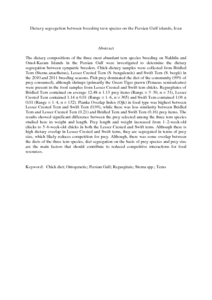Citation
Tayefeh, Farhad Hosseini and Hussin, Mohamed Zakaria and Amini, Hamid and Mohammadnejad, Jamshid and Darvishi, Khosro and Karami, Sirous
(2014)
Dietary segregation between breeding tern species on the Persian Gulf islands, Iran.
Waterbirds, 37 (3).
pp. 307-318.
ISSN 1524-4695; ESSN: 1938-5390
Abstract
The dietary compositions of the three most abundant tern species breeding on Nakhilu and Omol-Karam Islands in the Persian Gulf were investigated to determine the dietary segregation between sympatric breeders. Chick dietary samples were collected from Bridled Tern (Sterna anaethetus), Lesser Crested Tern (S. bengalensis) and Swift Tern (S. bergii) in the 2010 and 2011 breeding seasons. Fish prey dominated the diet of the community (99% of prey consumed), although shrimps (primarily the Green Tiger prawn (Penaeus semisulcatus) were present in the food samples from Lesser Crested and Swift tern chicks. Regurgitates of Bridled Tern contained on average 12.48 ± 1.13 prey items (Range = 3–30, n = 31), Lesser Crested Tern contained 1.14 ± 0.01 (Range = 1–6, n = 365) and Swift Tern contained 1.08 ± 0.01 (Range = 1–4, n = 132). Pianka Overlap Index (Ojk) in food type was highest between Lesser Crested Tern and Swift Tern (0.98), while there was less similarity between Bridled Tern and Lesser Crested Tern (0.21) and Bridled Tern and Swift Tern (0.16) prey items. The results showed significant difference between the prey selected among the three tern species studied here in weight and length. Prey length and weight increased from 1–2-week-old chicks to 5–6-week-old chicks in both the Lesser Crested and Swift terns. Although there is high dietary overlap in Lesser Crested and Swift terns, they are segregated in terms of prey size, which likely reduces competition for prey. Although, there was some overlap between the diets of the three tern species, diet segregation on the basis of prey species and prey size are the main factors that should contribute to reduced competitive interactions for food resources.
Download File
![[img]](http://psasir.upm.edu.my/37102/1.hassmallThumbnailVersion/Dietary%20segregation%20between%20breeding%20tern%20species%20on%20the%20Persian%20Gulf%20islands.pdf)  Preview |
|
PDF (Abstract)
Dietary segregation between breeding tern species on the Persian Gulf islands.pdf
Download (152kB)
| Preview
|
|
Additional Metadata
Actions (login required)
 |
View Item |

